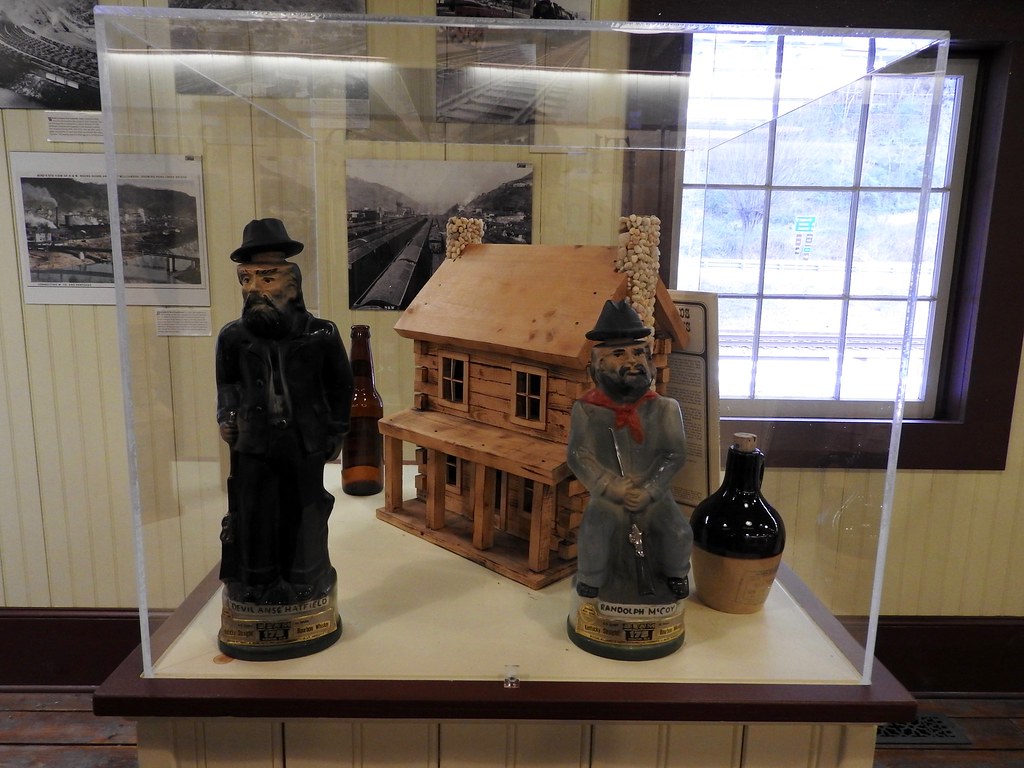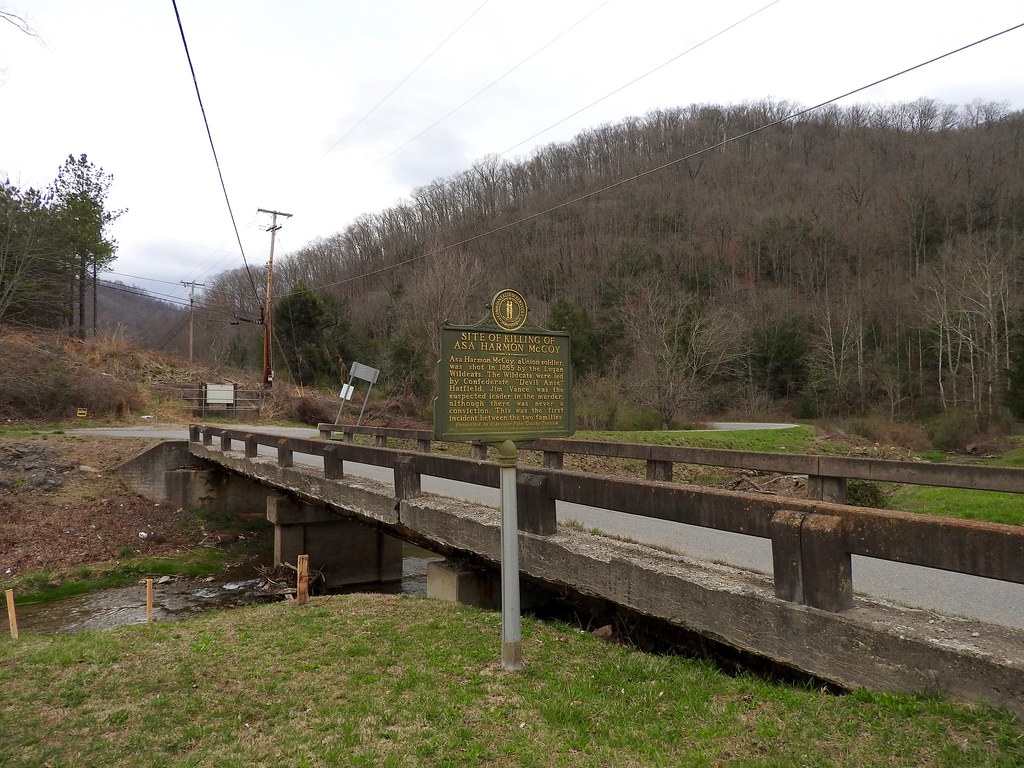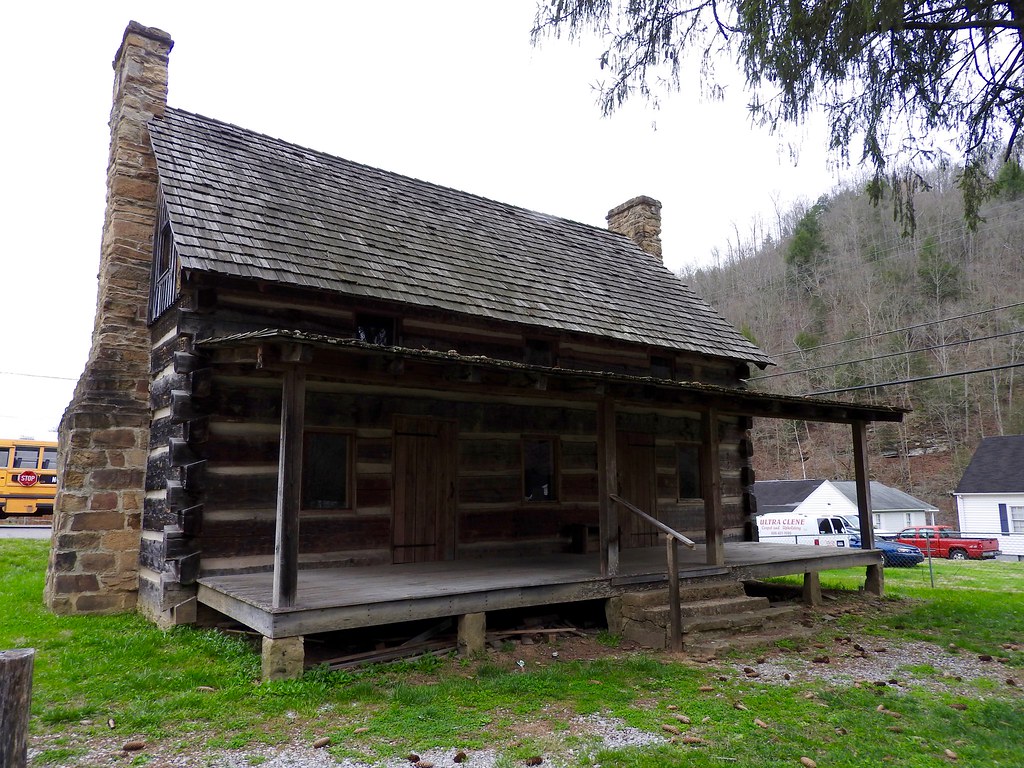I wondered what we might do during our brief Appalachian adventure beyond my stated purpose. Originally I simply wanted to collect Virginia’s final counties. I would have been happy to drive the full distance without stopping although that wouldn’t have been fair to my passengers. However, there didn’t seem to be much in the way of traditional tourist attractions as I started plotting a possible route.
The Twelve Mile Circle audience helped with my initial planning. Then I continued to examine and dig on my own. Eventually I cobbled together enough sites to make the trip worthwhile. I noticed a productive path would take us through Mingo County, West Virginia and Pike County, Kentucky. Those were ancestral homes of the Hatfield and McCoy clans. Their extended families gained fame for their epic feud during the latter part of the 19th Century. Perhaps we could focus some attention on Hatfield and McCoy country as we drove through.
Notoriety

I’d bet that nearly every 12MC reader, even those living far beyond the United States, has heard of the Hatfield and McCoy feud, right? I won’t bother to go into depth about every blow and counter-blow that happened. There are plenty of summaries available. Instead, I’ll merely outline a handful of historic spots we visited during a single Saturday afternoon in mid-March. A worthy visit would probably take two or three full days even with several sites located close together. That assumes one wanted to cover every site in detail. Unfortunately, we didn’t have that luxury due to our schedule.
The feud fizzled into benign family-friendly events long ago. For instance, Pike County, Kentucky sponsors the annual Hatfield McCoy Heritage Days (“The feud is over, let the fun begin!“). Nearby in Williamson, West Virginia, they hold a Hatfield McCoy Marathon (“No Feudin’, Just Running!“). However memories remained deeply rooted in local culture. It’s important enough to earn a permanent exhibit at the West Virginia State Museum in Charleston. Our stop there set a context for some of the actual sites we would see later in the day.
Stereotype and Parody

The feud escalated in intensity just as American newspapers turned to stories from the Heartland. Influential papers with large circulations controlled information in major industrial cities. They also competed amongst themselves to attract readers and scoop their rivals. Sometimes they featured lurid tales of “unsophisticated” outsiders who lived differently than the urban ideal.
The Hatfields and McCoys fell into this dynamic quite by happenstance. City papers exaggerated and spun events into vicious hillbilly stereotypes. Then these notions permanently attached themselves to the collective national psyche. Appalachian residents spent their days swilling moonshine, marrying family members, chasing hogs and shooting each other for trivial reasons if news reports of the day were to be believed. These crude exaggerations carried into modern times.
The Matewan Museum displayed a fascinating set of Hatfield and McCoy whiskey bottles from the 1970’s. Thus, even decades later, misinformed public perceptions still existed.
Hatfield-McCoy Monument

It seemed fitting to begin our brief tour at the Hatfield-McCoy Monument (map). Erected in 2012, it offered a more balanced and nuanced view of events than a century before. Its crooked shape represented the Tug Fork of the Big Sandy River, the boundary between West Virginia and Kentucky through these parts.
William Anderson (“Devil Anse”) Hatfield served as the patriarch of his family living primarily on the West Virginia side of the line. Randolph (“Randall”) McCoy filled a similar role for his mostly Kentucky-based clan. Plaques placed along the top of the twisting wall described a feud as it progressed chronologically. However each plaque was divided, written from a Hatfield perspective on the side representing West Virginia and McCoy on Kentucky (photo). One could walk along the length of the “river” to understand how events escalated from both points of view.
The Killings Began

Up the road, maybe another mile, marked a point where the feud began to intensify (map). Animosities long simmered between the families. However they didn’t resort to bloodshed until 1865.
Asa Harmon McCoy, brother of Randall, returned to Kentucky after being discharged from the Union army. The Logan Wildcats, a Confederate guerilla unit based in nearby West Virginia led by Devil Anse Hatfield, tracked Asa to this spot and killed him. Nobody was ever convicted. This would be the first of several deaths.
Hog Trial

It might seem peculiar that a dispute over a hog could incite fierce hatreds. Nonetheless, hogs were particularly valuable to the self-reliant people of Appalachia. Randolph McCoy believed that Floyd Hatfield (Devil Anse’s cousin) stole one of his hogs in 1878. So he took him to court.
Rev. Anderson Hatfield (another cousin) served as Justice of the Peace at the time and presided over the trial (map). The preacher hoped to remain impartial in spite of his surname. Thus he appointed a jury of six Hatfields and six McCoys. William Staton, Floyd’s brother-in-law but also a McCoy cousin, testified that the pig belonged to Floyd. That was enough to convince a single McCoy to join six Hatfields and vote for acquittal. The McCoys viewed Staton’s testimony as a vicious betrayal, and a McCoy killed Staton a few months later. He was tried and acquitted.
Pawpaw Tree Incident

Election time came in 1882 and Tolbert McCoy got into a drunken argument with Ellison Hatfield. Tolbert and his brothers Pharmer and Randolph Jr. stabbed Ellison to death. In retaliation, the Hatfield clan seized the McCoy boys. Then they tied them to pawpaw trees along the Kentucky bank of the Tug Fork (map) and shot them fifty times before slipping back into West Virginia.
Matewan Flood Wall

Those events barely scratched the surface of important Hatfield and McCoy sites in Pike and Mingo Counties. There were other violent incidents of arson, betrayal, murder, and at least one star-crossed love affair. The feud didn’t begin to dissipate until most of the primary participants either met a brutal fate or languished in prison.
The tourism potential was just starting to catch-on at the time of our visit. It had been fueled in large part by the 2012 Hatfields & McCoys television miniseries starring Kevin Costner. Still it surprised me that these sites weren’t better publicized. It took some fairly intense internet searching on my part to pull together a cohesive route. Maybe someday I’ll be able to return and finish the rest.
Whatever embarrassment may have existed seemed to have vanished along with the feud itself. References to Hatfield and McCoy appeared everywhere within the area. Both families even had decorative panels on the flood wall at Matewan, the town at the heart of the conflict (map).
Matewan Hatfield/McCoy Intersection

Matewan even renamed a couple of its streets, forming the intersection of Hatfield and McCoy (map). Naturally I had to find it. Twelve Mile Circle deserved no less. I wonder how they decided McCoy would come out on top of Hatfield?
Appalachian Loop articles
See Also: The Complete Photo Album on Flickr

Leave a Reply